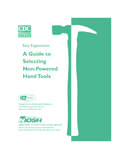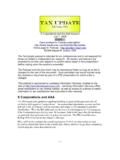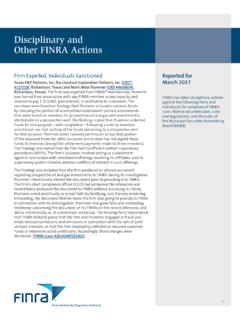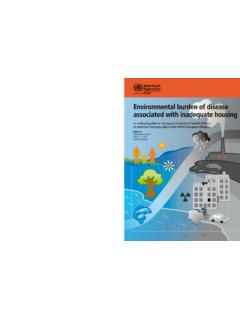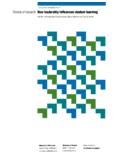Transcription of SUMMARY - WHO | World Health Organization
1 SUMMARY Proportion of all deaths attributable to tobacco (%)WHO RegionMenWomenAll adults African513 Americas171516 Eastern Mediterannean1227 European25716 South East Asian14510 Western Pacific141113 Global16712 Globally 12% of all deaths among adults aged 30 years and over were attributed to tobacco. In 2004, about 5 million adults aged 30 years and over died from direct tobacco use (smoking and smokeless) around the globe, that is one death approximately every six seconds. The regions with the highest proportion of deaths attributable to tobacco are the Americas and the European regions where tobacco has been used for a longer period of time.
2 The proportion of mortality attributable to tobacco is higher among men than among women. Globally, 5% of all deaths from communicable diseases, and 14% of all deaths non-communicable diseases among adults aged 30 years and over are attributable to tobacco. Within communicable diseases, tobacco use is responsible for an estimated 7% of all deaths due to tuberculosis and 12% of deaths due to lower respiratory infections. Within non-communicable diseases, tobacco use is responsible for 10% of all deaths from cardiovascular diseases, 22% of all cancer deaths, and 36% of all deaths from diseases of the respiratory system. Globally, death from people who died from tobacco-related diseases of the cardiovascular system was more likely to occur among younger adults.
3 Of those adults aged 30-44 years who died from ischemic heart disease, 38% of the deaths were attributable to tobacco. 71% of all lung cancer deaths are attributable to tobacco use. 42% of all chronic obstructive pulmonary disease are attributable to tobacco use. The reliance of reliable data on lung cancer deaths as the starting point of estimating the SIR means is of paramount importance in the estimation of deaths attributable to tobacco not only for lung cancer but for a variety of other causes of death. Some countries with a relatively recent history of tobacco use (particularly manufactured cigarettes) may not yet exhibit substantial levels of lung cancer.
4 By extension of the model, information on other causes of death would, as a consequence also be lacking, likely yielding an underestimate of the real levels of death attributable to tobacco, particularly but not exclusively among women. This situation applies in several regions, including for example Solomon Islands, Sri Lanka, Mauritania and Haiti. The results for China were also interesting with crude proportions of death attributable to tobacco being 12% for men and 11% for women. These levels appear to be very high when put in context of the published differential in men and women smoking rates in China (17, 18). There are, however, important differences between the patterns for men and women.
5 The age-specific rates for men were about four times higher than those for women at ages 30-44 and 45-59, and times higher for the age group 60-69 years. It is only at the very high ages (70 years and over) that the rate for women is higher than that for men. After adjusting for these different age-patterns (through the technique of age-standardisation), the male rate was times that for women. Two additional factors could also account for the remaining closeness between the rates for men and women. Although this project did not include exposure to second-hand smoke, there is increasing evidence that SHS also contributes to the development of cancer.
6 Given the very high rates of smoking among Chinese men, it is possible that these translate into high rates of secondhand exposure among Chinese women (particularly those in the highest age groups), and these could in turn have an excess impact on cancer rates among Chinese women. In addition, it is possible that the smoking rate among women in China is under-reported. A recent study in neighbouring South Korea reported some under-reporting in that country (19). Although there are cultural differences between China and Korea, the Korean result indicates that it may be desirable to explore the possibility of this also occurring in neighbouring China.
7 The issue of smokeless tobacco for Bangladesh, India and Pakistan is partly reflected in the substantial category of All other neoplasms . Globally 12% of all deaths among adults aged 30 years and over in that category were attributable to tobacco compared with 16% in India , 17% in Pakistan and 31% in Bangladesh. Some countries mostly those with adequate cause of death and tobacco use prevalence data produce tobacco attributable mortality estimates using estimates of tobacco use prevalence directly to estimate their PAFs. These methods produce estimates that may be somewhat different from those produced by the SIR method but are equally valid.
8 Danaei et. al (20) have shown that the specific PAF method used by the United States (often referred to as the SAMMEC method) yields results that are essentially consistent with those produced by the PAF/SIR method. Examples of countries that have generated their own estimates using PAF methods for example include Brazil, Canada, France, Ireland and the United States. A careful and detailed review of the PAF/SIR method by Khanna & Stevens (21) indicates that the method has been well received, applied and refined in a variety of reports and publications that have produced tobacco-related burden of disease estimates. The incompleteness of the raw mortality data from many countries have limited their access to information of relatively adequate quality to enable them to inform their Health policy and program development efforts.
9 The modelling of the basic mortality data by WHO, especially those for many low and middle income countries, has permitted the production of indicative estimates of mortality attributable to tobacco reported in this document. Improvements in vital registration systems will enable the production of more precise estimates of tobacco attributable mortality, enabling WHO Member States in enhancing their tobacco control efforts. WHO estimated death rates (per 100,000) and proportion attributable to tobacco, 2004 Cause of death30-4445-5960-6970-7980+Death rate: ALL CAUSES382 880 2,304 5,188 12,806 1,482 AgeMaleFemaleTotalDeath rate attributable to tobacco27 120 333 658 1,227 174 0-291,795,664 1,701,288 3,496,952 Proportion of deaths attributable to tobacco (%)7 14 14 13 10 12 30-44689,611 670,666 1,360,277 45-59454,973 455,679 910,652 Death rate.
10 Communicable diseases154 163 269 485 1,235 226 60-69171,266 186,019 357,286 Death rate attributable to tobacco4 6 14 28 132 11 70-7996,013 120,504 216,517 Proportion of deaths attributable to tobacco (%)2 4 5 6 11 5 80+30,363 53,228 83,591 Total 3,237,891 3,187,384 6,425,275 Death rate: Tuberculosis27 39 60 66 58 39 Death rate attributable to tobacco2 3 4 4 4 3 Proportion of deaths attributable to tobacco (%)9 8 7 5 8 7 Death rate: Lower respiratory infections12 26 112 253 805 69 Death rate attributable to tobacco1 3 10 24 126 8 Proportion of deaths attributable to tobacco (%)11 11 9 9 16 12 Death rate.













